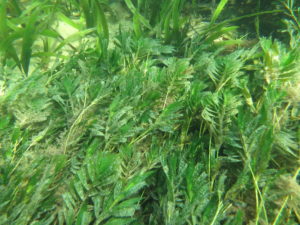The Sea Nymph — Amphibolis antarctica a seagrass only found in the cooler ocean waters of Australia
The Park of the Month January 2017 was Encounter Marine Park

Sea-nymph, Amphibolis antarctica, South Australia in foreground. Photo: KJ van Dijk.
Our plant of the month for January, the ‘sea nymph’, Amphibolis antarctica, is an Australian endemic species of seagrass which typically occurs in cooler temperate oceanic waters. The earliest collections of Amphibolis antarctica are likely to have been made on the Baudin expedition which were then used by P. Labillardière in 1807 to describe the new species. Plants of the genus Amphibolis are characterised by having a cluster of leaves at the end of sinuous, wirey stems.
Amphibolis antarctica is often found growing attached to rocky or harder substrates, the rhizome and root mat helping them attach by growing into crevices and enabling plants to cling to locations where other seagrasses might become detached. For this reason, Amphibolis antarctica is associated with rocky reefs, limestone and granitic underwater reefs. Amphibolis plants create a significant 3 dimensional surface area for other plants and animals to use as their home and these epiphytes and epifauna are often very obvious elements of local communities.
There have been declines in areas of Amphibolis antarctica and its sister species Amphibolis griffithii closer to the Adelaide Metropolitan region historically, and some areas on Kangaroo Island. The declines have been shown to be due to poor water quality.
Amphibolis plants produce unusual seeds – they in fact form seedlings which remain attached to the mother plant for months after they are formed and then detach and float away to settle as seedlings. This allows them to travel long distances and gives the seedlings of the sea-nymph a better start in life. Research in partnership between the State Herbarium, the University of Adelaide and Murdoch University is studying how genetically diverse populations are and how far the seedlings might travel. A field guide is available that explains more information on Southern Temperate Seagrasses including the sea-nymph.
The Encounter Marine Park is covers 3,119 square kilometres of the Gulf St Vincent and Coorong Marine Bioregions and extends from southern metropolitan Adelaide waters around the Fleurieu Peninsula and past the Murray Mouth to the Coorong coast. A baseline report on the Encounter Marine Park published last year summarised our knowledge of the reserve.
This Encounter Marine Park region contains some very large areas of seagrass and supports numerous fisheries species and other species of conservation value such as the Leafy Sea Dragon. In fact, the density of leafy sea-dragons was surveyed by divers using photo-identification methods near West Island, with density estimated at 57 per hectare (see baseline report on EnviroData SA).
